Charles Brooks slung his pick-ax into the soil. It was a simple job, leveling some ground for landscaping. (He’s also pretty handy with an Enterprise drone, and we’ll get to that shortly.)
It felt good. That’s because it wasn’t just any pick-ax, and it wasn’t just any earth.
That tool, now sporting a new hickory handle, had first been in the hands of his grandfather. It had been handed down, over many decades, until it had reached Charles. It’s already been in the hands of one of his sons, currently aged 9 and 11. That makes four generations who have touched this tool.
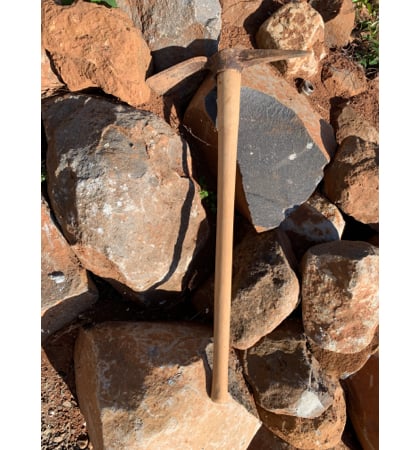 For Charles, it’s more than a useful implement. It’s a piece of family history, continuity. That heritage has often crossed his mind when he’s used the tool over the years, but using it on this particular job felt even more satisfying.
For Charles, it’s more than a useful implement. It’s a piece of family history, continuity. That heritage has often crossed his mind when he’s used the tool over the years, but using it on this particular job felt even more satisfying.
That’s because he recovered that pick-ax from the ashes of his family’s home in Paradise, California – one of some 19,000 structures consumed by a devastating wildfire, known as the Camp Fire, that struck in November of 2018. The insured losses from that fire, some $16.65 billion, make it the most expensive natural disaster in the world. It was also the deadliest wildfire in the US since 1918.
For nearly 2-½ years, Charles and his family waited as plans were finalized, surveys were collected, permissions were obtained and, finally, construction of their new home – on the same patch of earth – was completed.
During that period, Charles juggled working with an architect on a new home design, selecting a builder, and making the countless other decisions that come with building a new home from scratch – including replacing all of its contents. That’s in addition to being a dad and a husband.
But Charles has also been rebuilding in a larger sense; founding and running an organization that has been helping others return – and bring Paradise back to life. And it is here that drones have played a significant role.
Paradise Lost
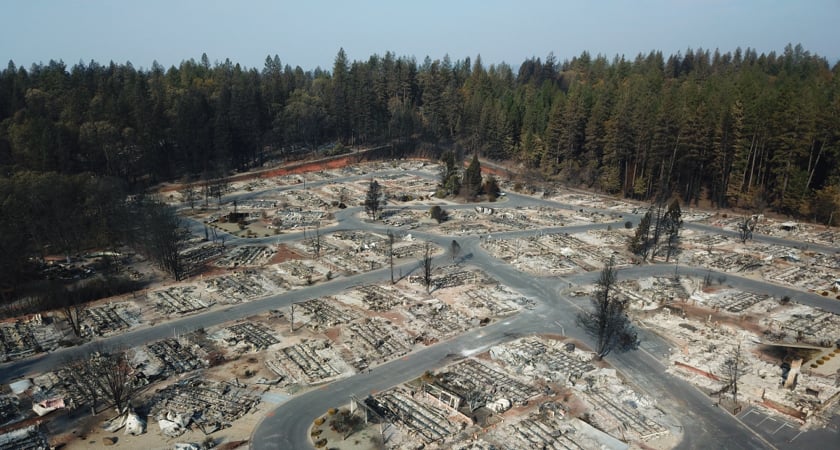
November 8, 2018, was going to be a hot day. But Charles loves the outdoors and regular hikes. He’d already been out, at 5:00 AM, for a hike in the Feather River Canyon. He and his fellow hikers commented on the weather conditions. It was already windy, which is unusual at dawn. And the woods were tinder-dry.
He returned home after the hike, getting ready to take his two sons to school. His wife was already at work in the city of Chico (about a 25-minute drive away) when his older son came upstairs with some news. Dad, he said, I smell smoke.
Scant minutes later, the sky was changing colors. Charles turned on a scanner and quickly heard a request for resources. There was a fire underway in the nearby community of Concow, just a few miles away in Butte County. Charles was wary, but not yet alarmed. Wildfires are part of life in this neck of the woods, so he proceeded to get the kids ready for school.
And then the phone rang, just as it simultaneously rang for many other Paradise parents. It was an automated call from the school, with a message a woman had recorded moments earlier. There’s fire nearby. Don’t take your kids to school.
Charles shifted plans, deciding to take his kids to work with him. But as he drove to the office, the signals were unmistakable. The sky was shifting, darker, ominous. Something about it was different, dangerous. He turned the car around and started to head home. Embers began falling from the sky like fiery rain, landing on the car, the grass, nearby buildings.
He got out of the car and recalls saying to a neighbor: “This isn’t looking good.”
“And then a burning stick fell in front of me, and it was: ‘We’re out of here.’”
Charles rushed into the house, knowing he had only minutes for this mission. He bundled up a bag of clothes for the kids and grabbed a hard drive with family photos on it. Then it was straight into the nearby city of Chico. What’s normally a quick drive took Charles about an hour and 45 minutes due to traffic and deteriorating conditions.
“My neighbors left 15 minutes behind us. It took them 5-½ hours to get out.”
Those neighbors, and many others, had to drive through a literal firestorm. The sun was blocked by thick smoke, turning that drive into a maelstrom of sparks and flames and smoke. The terror of the scene, and the voyage, is documented in the Netflix documentary Fire in Paradise.
The trailer provides an inkling of what that was like.
“Throughout the day, looking up from Chico, the entire sky was filled with black smoke. And friends were texting – then you wouldn’t hear from them again for eight hours.”
Charles and his wife knew their home would likely be gone; an acquaintance drove by his lot the following day and confirmed it.
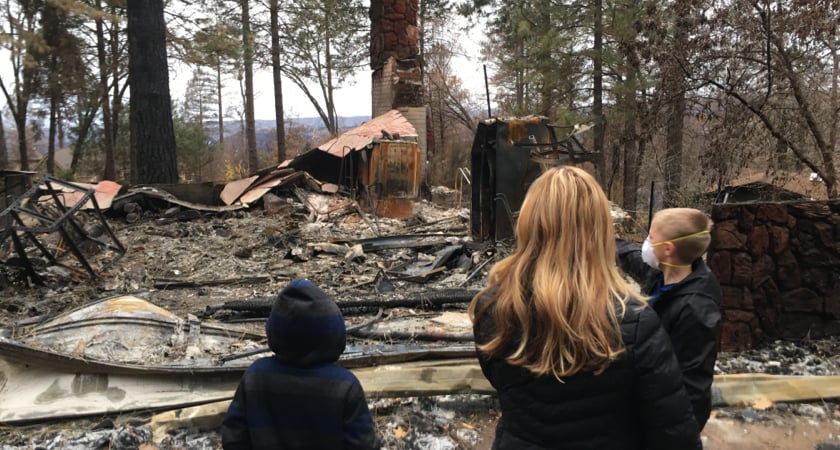 Charles’s wife Jennifer and their two sons on their lot after the fire destroyed their home. Charles Brooks photo
Charles’s wife Jennifer and their two sons on their lot after the fire destroyed their home. Charles Brooks photo
Charles and his family had nothing – but also everything. They had survived; 85 others had not.
Rebuild Paradise
Charles Brooks is not one to wallow in self-pity. He’s the opposite; a driven, hands-on problem-solver who likes to fix things and get things done. He was on the phone with an architect the day after the fire: They would rebuild.
He also felt, strongly, a call of duty to help others in the broader community. It would take a lot of work to rebuild Paradise beyond the bricks and mortar. People would need help accessing resources, incentives, encouragement to return and resettle in a place where nearly everything had been lost. (Ninety-three out of every 100 structures in Paradise were consumed by the fire, including 11,000 homes.) Many experienced trauma while escaping, on top of the shock of losing homes and possessions.
“I feel an obligation to the community and to its people,” he says. “I couldn’t imagine doing anything else with my life. I wanted to see my kids playing soccer (there) again.”
This is doable, he thought.
He contacted Sonoma’s Rebuild Northbay Foundation, which “is committed to the long-term rebuilding of our disaster-affected communities as more sustainable and resilient through Advocacy, Coordination and Economic Development.” He told the Foundation what he wanted to do. And that Foundation, led by Jennifer Gray Thompson, offered its unconditional support.
Roughly two months after the fire and with Jennifer cheering him on, Charles Brooks founded the Rebuild Paradise Foundation. Its mission: “To support the long-term rebuild efforts of Butte County’s disaster-affected residents, businesses and workforce… We are here to help rebuild Butte County after the Camp Fire and future disasters. We wish to rebuild our community to be safe, sustainable, and bring back the vibrancy that once was.”
And soon, drones would enter the equation.
You can see Charles explain what the organization does in this brief video:
The DJI Connection
Charles had no experience with drones. But he would soon meet up with a person who did.
Aaron Lambert is the Aerial Operations Manager at General Pacific, a major distributor of the bits and pieces, large and small, used by electrical and water utilities as well as contractors – everything from power poles to conduits to EV chargers to water meters. Lambert runs a subdivision of the company, GenPac Drones. In addition to hands-on training and running NIST (National Institute of Standards and Technology) courses, it’s also a DJI Enterprise dealer.
As fate would have it, both Lambert and Charles Brooks happened to attend the same structural engineering conference in Tahoe in August of 2019. That’s where they met and first discussed how drones might be part of the Rebuild Paradise equation.
Just as Brooks felt compelled to help his community rebuild, Lambert wanted to offer some sort of contribution. Though he wasn’t personally connected with Paradise, he was well aware of the devastation, along with some of the immediate needs. Charles had explained that people who wanted to rebuild on their sites required contour mapping, an additional expense when many people were already hurting financially.
“Let’s just be good people,” Lambert recalls thinking. “There’s got to be some way to help them out.”
DJI gets involved
Lambert already had some good connections at DJI, including Romeo Durscher, who was then the company’s Senior Director of Public Safety Integration. In fact, Romeo helped spearhead ambitious drone mapping and high-resolution aerial missions using DJI products after the most intense phase of the fire had passed through Paradise. (Much of that Camp Fire map imagery can be found here.)
Durscher, of course, was very familiar with the devastation. (Some of the images captured during the missions he oversaw had to blur out safes, still sitting amidst the ashes of former homes, to deter looters.)
“I went to DJI and I said: ‘This is urgent. This was one of the worst fires in California history, it’s a big deal,’” recalls Lambert. “‘There’s gotta be some good here, too.’ I just didn’t want them to be forgotten.”
He made the ask: A single Phantom 4 RTK, where the RTK stands for Realtime Kinematic Positioning. The drone is specially designed for surveying and can achieve a Ground Sampling Distance accuracy of 2.74 centimeters at 100 meters altitude when used in conjunction with a DJI Mobile station. The right drone – and this was definitely the right drone – could assist in preliminary survey work. Specifically, it could capture and map contours. It’s a piece of data everyone rebuilding would require, and it could potentially save people money during a time of hardship.
The request went up DJI’s chain of command and the company was quickly back with a decision: It would not provide a single Phantom 4 RTK.
Rather, it would donate three of the machines and a D-RTK 2 Mobile Station to the Rebuild Paradise Foundation. The gear is worth more than $25,000.
Charles would name two of the drones Phoenix 1, Phoenix 2. The perfect name for machines that would take flight from the ashes.
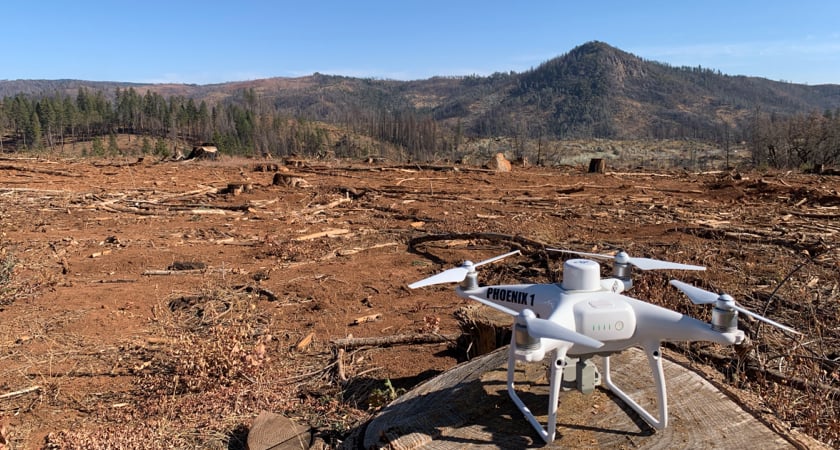 “Phoenix 1” – one of three Phantom 4 RTK drones DJI donated to the Rebuild Paradise Foundation. Photo courtesy of Charles Brooks
“Phoenix 1” – one of three Phantom 4 RTK drones DJI donated to the Rebuild Paradise Foundation. Photo courtesy of Charles Brooks
Airborne
That’s when the real work began. In March of 2020, Aaron Lambert made a trip to Paradise to offer on-site training. General Pacific was totally onside and covered his costs. Though Aaron had a pretty good inkling of what he would find, nothing could really prepare him for the devastation.
“That was a very humbling experience to see first-hand – even two years after,” he says. “Some growth was starting to come back, but there was still so much barren ground. I was at a loss for words just listening to people and their stories. It’s hard to describe.”
And then the drone work began. Aaron trained Charles and one of the Rebuild Paradise Foundation’s video production interns how to operate the Phantom 4 RTKs. The pair also hit the books and obtained their Part 107 licenses for commercial drone operation. Soon, they were doing maps. Aaron returned to his home base in Oregon, but kept up the contact with Charles.
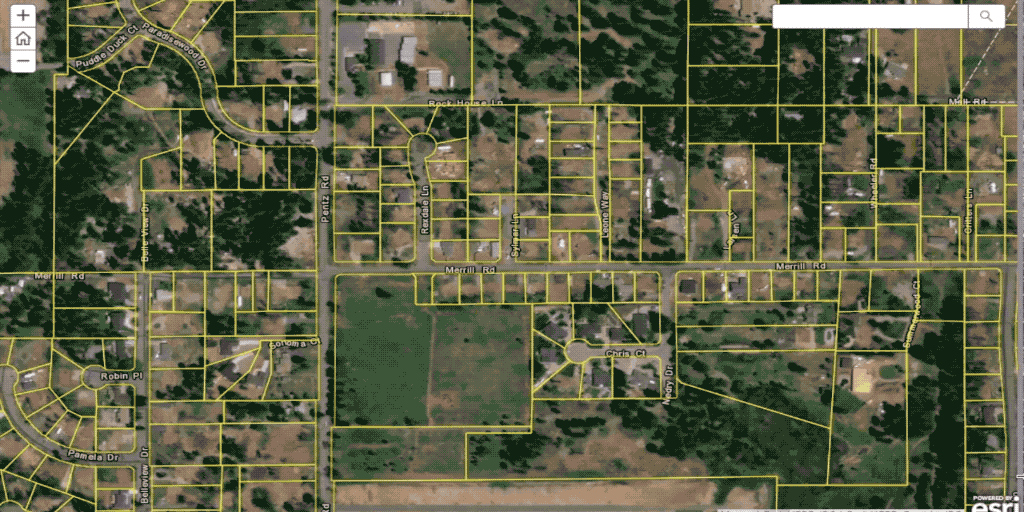
“He (Charles) kept calling me, saying: ‘I’m taking it (the data) to well-known surveyors in the industry and they’re like: ‘This is extremely good data’.’”
Drone Deploy also kicked in, providing Rebuild Paradise with a free Enterprise membership; DJI offered its Terra mapping software free of charge, as well.
“I’m honestly awestruck sometimes at the amazing capabilities,” says Charles. “In five minutes of flight time, we can get the level of details that would take three or four hours of walking on the ground with a handheld (sensor), then get that ultimate unique perspective of an orthomosaic map. It makes a design professional’s job so much quicker that all the key infrastructure on a property can be measured. And that you can do all that with a little device? Just incredible.”
Charles provided designers with updated imagery as lots were prepared and during construction. The data saved designers from having to make repeated trips to building sites each step of the way.
“The greatest value was the updated imagery,” he says. “So keeping those folks in the office with updated imagery, where they don’t have to be out in the field – that’s saving them a tremendous amount of time and money… That’s our agreement with designers, is that any savings are passed along to the end-user.”
#DronesHelp
Charles proved an excellent pilot. Once he’d mastered contour missions, he began adding more complex missions to his portfolio. As Lambert puts it: “He’s really grown.”
“When Aaron trained us, I couldn’t believe a drone could be that stable,” says Charles. “I’ve just fallen in love with flying those things and how capable they are.”
In addition to work on construction sites, the drones have been deployed to document the changes as some 300,000 dead and dying trees are removed from the widespread fire area. Everytime they go up to fly, the landscape changes.
Data the Foundation has obtained for the local Fire Safety Council, says Charles, has been “incredible” – including capturing parks and other buffers that will be used as safety zones to help ensure another wildfire could never spread like the Camp Fire did.
DJI helps tell the story...
The video production intern also became pretty handy at the sticks; soon, Rebuild Paradise also began using the drone for other purposes, including visual storytelling and 360° imagery. Drone shots play a prominent role in many of Rebuild Paradise’s videos:
(Footage and photos captured during this historic period of transition are being archived, and will one day be turned over to the repository of local history: The Golden Nugget Museum.)
One of those three drones is also currently on loan to the local Search and Rescue team, another #DronesHelp application that resulted from DJI’s decision to donate multiple Phantom 4 RTKs to the cause.
Paradise Found
Rebuilding Paradise is no small task. It will take years, and even then it won’t be the same as it was. It will be safer, for one thing, with plenty of buffers and a reduced number of trees to stop the kind of firestorm the city endured in 2018. Houses, too, are being rebuilt to current standards, which will aid in fire resistance.
If you look at a few of the Rebuild Paradise Foundation’s videos, you’ll note a series of them are titled Returning to Paradise. They document people in the midst of rebuilding. They share the kind of hope and optimism that’s part of the very fabric of Charles Brooks.
“Charles is a star, a light in that community,” says Aaron.
And Charles? He has similar words for Aaron.
“He didn’t have to do this. He believed in us and just wanted to help. He has a heart of service.”
And DJI?
“I’m beyond grateful for the amazing gift from DJI,” says Charles. “I never expected anything like that in a million years. We’re trying to do right by this gift and benefit our community and other communities. We’re truly humbled and grateful.”
Home again
In late March, Charles and his wife Jennifer and their two sons did something they’d been looking forward to for a very long time. They moved into their new house.
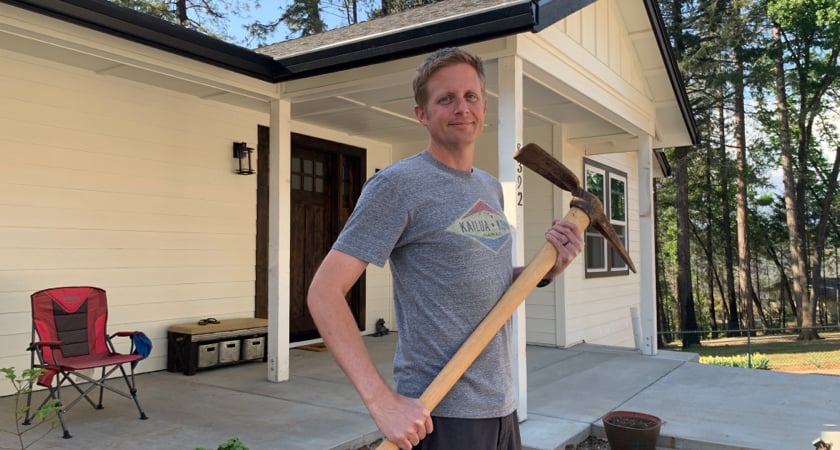 Charles Brooks and his pick-ax, with replacement handle, recovered from the ashes. Photo by Tyler Brooks
Charles Brooks and his pick-ax, with replacement handle, recovered from the ashes. Photo by Tyler Brooks
It wasn’t long, just a couple of weeks later, that some landscaping needed to be done. Charles Brooks stood in his yard, holding the pick-ax that had belonged to his grandfather, and then his father, and now him. He swung it into the earth, where it made a satisfying thud.
He was, again, truly home. In Paradise.


.png?width=300&name=L3kv%20(1).png)

.png?width=300&name=FH2%20update%20(1).png)
-1.png?width=300&name=HS%20-%20Featured%20Images%20(3)-1.png)